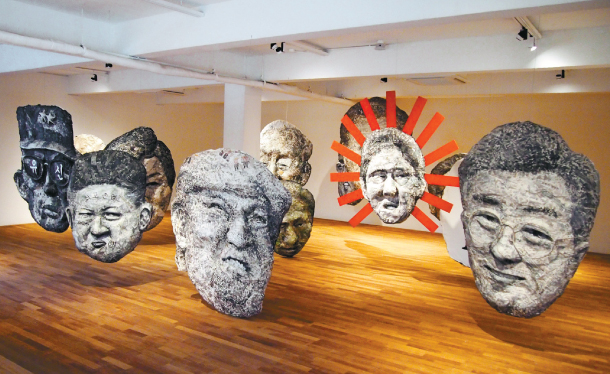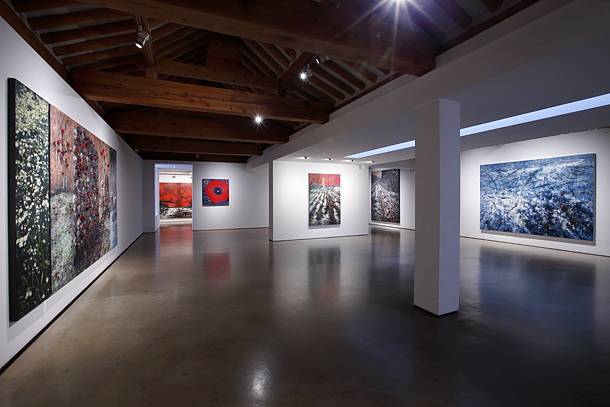Political expression goes from streets to galleries : Anti-government protests have given artists space to create

Masks of various world leaders throughout history are on display at the Gana Art Center in central Seoul, at Lim Ok-sang’s exhibit, which runs until Sept. 17. [YOON SO-YEON]
Another artist, Lim Ok-sang, became known for his life-sized paper mask of Park’s face that he carried around while walking the streets each weekend.
The Gana Art Center in central Seoul opened the “Lim Ok-Sang: The Wind Rises” exhibition on Aug. 23. In the exhibit, which runs until Sept. 17, Lim presents 14 large-sized masks showing the faces of world leaders from across generations. From Park Geun-hye, to her late father Park Chung-hee, President Moon Jae-in to President Donald Trump of the United States, the exhibition starts with Lim’s humorous, yet strong identity as a “Minjung artist.” A Minjung artist refers to a group of artists who, similar to the Minjung, or public, political and social movements, sought to bring about democracy through art during the 1980s military dictatorship.
“Back then, during the candle light vigils, the government threatened that if protestors wore masks, that they would treat us like terrorists - like IS [Islamic State],” said Lim on Aug. 22 during a press meeting. “So I made a mask of Park Geun-hye’s face to say, ‘Hey, this is your face, what are you going to do about it?’ Then I went on to make masks of the leaders of other countries and generations. That’s how the series began.”
Lim is part of the first generation of Minjung artists, who was a part of an organization called “Reality and Speech” that stood in the center of Minjung art movements. As a Minjung artist, Lim observed social problems in the 1980s and voiced his opinions through various forms including paintings, sculptures, craft and live performances.
“We say something by not saying anything,” said Lim. “Silence is the language of art. My works are about what’s here right now.”
The artist’s works are indeed greatly influenced by what’s been on the news lately. Throughout the exhibit, works inspired by the pro-democratization vigils that took place last year in Gwanghwamun are on display, including a 160-meter (175-yard) long painting titled “Tide of Candles,” which depicts a night in Gwanghwamun Square, where Korean citizens called for justice be served. The paintings in the second part of the exhibit capture the moments in modern Korean history when the government failed to protect its own citizens, such as the death of farmer Baek Nam-gi, who was struck by a police water cannon in November 2015 during a protest.
“The goal of Minjung art is to help citizens find themselves and let them come forward with their own voice and express themselves,” said Lim. “It’s an honor that I’m called a Minjung artist, but it’s a shameful name, too. I haven’t been able to live up to that name. Now, I’m working more on the public side. I’m hoping that my works would open up something new for me.”

Song Chang’s “Flower-Shade” is open in Hakgojae Gallery, central Seoul, until Sept. 24. [HAKGOJAE GALLERY]
His latest pieces, however, extend beyond just the tragic history of the Korean peninsula. In many of his paintings after 2010, Song has stuck fake flowers on the canvas, each symbolizing a life sacrificed in the violence of war in the 1950s, which not only divided the two Koreas in half, but also took innocent lives.
In “The Spring of That Place,” a piece composed of three canvas paintings of different scenes, is a separate story of the death of UN soldiers who lost their lives on Korean soil and their dogs who wait for them in their home countries.
“Song Chang’s works look strong and critical, which they are on the surface, but they carry hopeful wishes of a peaceful future,” said Kim Han-deul, the curator of the exhibition. “By showing the tragic realities of Korea and the world, the artist is actually painting a hopeful future for all of us. For example, each flower stuck on the canvas symbolizes each death suffered by a soldier, but life in the future. Song’s messages are strong but they’re also very soft.”
BY YOON SO-YEON [yoon.soyeon@joongang.co.kr]










with the Korea JoongAng Daily
To write comments, please log in to one of the accounts.
Standards Board Policy (0/250자)